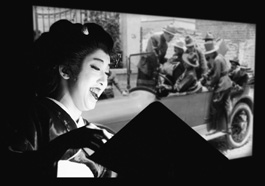home | metro silicon valley index | movies | current reviews | film review

Silent rush: A Japanese translator adds to the layers of meaning in 'El Automóvil Gris.'
Not-So-Silent Running
Mexican silent film classic returns, complete with music, narration, live actors
By Richard von Busack
IN HIS OLD AGE, director Emilio "El Indio" Fernández used to imply that he had sired the Mexican cinema. In an interview in Beatriz Reyes Nevares' book on Mexican film, Fernández recalled the 1943 premiere of his María Candeleria at the Palacio China Theater in Mexico City. There wasn't much of a turnout. The big three muralists—Siqueiros, Orozco and Rivera—were there. So was the film's star Dolores del Rio, who, faced with the emptiness of the theater, "literally wanted to die, perhaps even kill herself," said Fernández. But word got out. The film was a hit—the starter's pistol for la epoca del oro, the golden age of Mexican film.
Fernández had made an earlier movie, Flor Silvestre, which had in its cast a now-forgotten actress called Mimí Derba. Give Derba a close-up followed by a dissolve to a 1919 flashback.
San Francisco.com Real Estate
Moving to the Bay Area just became easy. Let San Francisco.com show you all the homes currently for sale.
San Jose.com Real Estate
Relocating to San Jose or Silicon Valley? Let San Jose.com introduce you to some expert area real estate agents.
Back then, Derba, a popular singer on the stage, was involved in the making of El Automóvil Gris, a now-obscure epic about a real-life crime wave that hit Mexico City. It was produced by Azteca Films, which Derba co-founded—the first native production company based in Mexico.
El Automóvil Gris recorded the crimes of the "Gray Car Gang" during the most dangerous year of the Mexican revolutionary period. In 1915, the government fled, and Mexico City was evacuated, as described in John Dos Passos' The 42nd Parallel. In the chaos, a crafty band of robbers masqueraded as soldiers. Carrying warrants and rifles, they looted the homes of the wealthy.
Documentary footage of the gang is mixed with dramatic re-enactments of how they formed and pledged themselves to crime. Although the marauders were eventually caught and punished, it seems possible that they had protection from higher-ups.
Film historian Sylvia Lim notes that the assistant chief of the military police, Juan Manuel Cabrera, co-wrote the script and played himself in the movie. We can only guess how much he embellished his part of the story. Even closer to the real-life case was the uncredited financier for the film—and Derba's lover—Gen. Pablo González. The general's name had been used to authorize some of the fake search warrants used by the Gray Car Gang, and he has been accused of masterminding the crimes.
The film was cut up from its original length, some three to four hours. Was it censors or the named producer that did the cutting? I've heard two different stories. The long version of the film was lost after 1933, leaving behind only an hour and a half of film. It was the last work by Enrique Rosas, a little-known cinematic pioneer who died young.
A biographical page on Rosas, when automatically translated from Spanish to English by a Google engine, describes how of "Enrique Pink" was "one of the great directors of the Mexican "dumb" cinema." "Mudo" is the Spanish word. "Mute cinema": this has an elegance missing from the other translation.
This tangle of language, that little demonstration of what gets lost in translation, fits in with the way El Automóvil Gris is going to be driven into San Jose's Mexican Cultural Center by Teatro de Ciertos Habitantes. This five-person theater troupe based out of North Carolina is directed by Claudio Valdés Kuri. Using projected intertitles, the group reinterprets the film—acts it out, dances to it and answers it back. The actors lip-sync it and put words into the mouths of its characters.
The 1919 film is accompanied by pianist Ernesto Gómez Santana and is given a live text in Japanese by Irene Akiko Iida, in Spanish by Enrique Arreola and in English by Thomasi McDonald.
The Japanese element is a nod to a Japanese art of film commentary: "Benshi." Japanese silent-movie commentators took the place of subtitles. Sometimes these performers had to improvise what was going on if they didn't have a clue themselves. (One could call the occupants of the MST3K "Satellite of Love" benshi-bots.)
Since I couldn't run down a copy of El Automóvil Gris, I'll repeat a received idea from descriptions of the film. It is supposedly influenced by Louis Feuillade's silent-movie serials about wily master-thieves terrorizing the upper-crust: Les Vampires, Fantômas and Judex.
The tighter a society is run, and the more corrupt it is, the more this society's movie audiences love stories of ominous master criminals. Certainly, no matter how it's framed, El Automóvil Gris is the estranged grandfather of the Mexican cinema, whose richness and ferment produced the big three today: Cuarón, Iñárritu and del Toro. And this obscure film is a priceless artifact of Mexico City of the teens—a city as long gone as Nineveh.
![]() El Automóvil Gris, a silent film with music and live performance, plays Jan. 31 at 7pm at the Mexican Heritage Plaza Theater, 1700 Alum Rock Ave., San Jose. Tickets are $5/$10. (408.928.5563)
El Automóvil Gris, a silent film with music and live performance, plays Jan. 31 at 7pm at the Mexican Heritage Plaza Theater, 1700 Alum Rock Ave., San Jose. Tickets are $5/$10. (408.928.5563)
Send a letter to the editor about this story.
|
|
|
|
|
|
